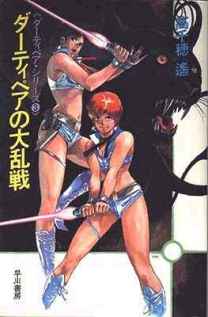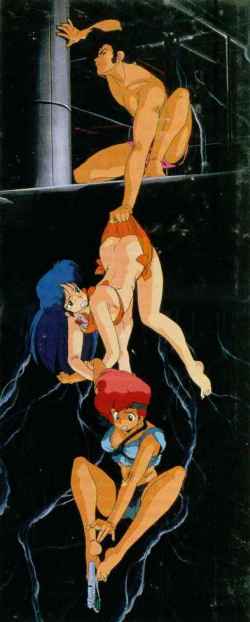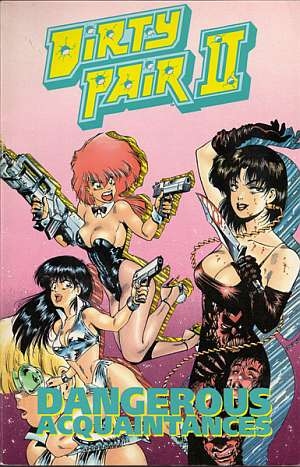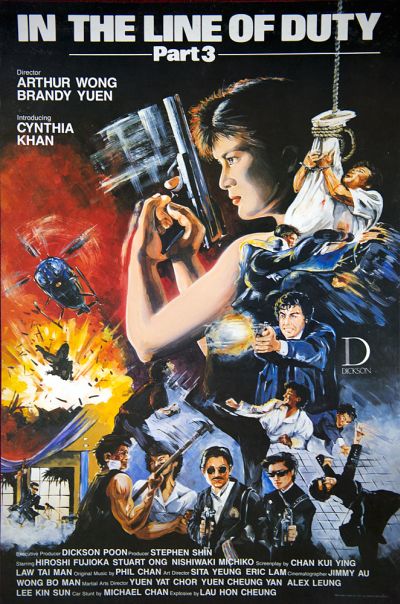“Anarchy in the Yuri-Kei”

 Few girls with guns creations have been as cross-media as Kei and Yuri, Haruka Takachiho’s Dirty Pair. Initially a collection of novels which began in 1979, they then became a TV show, a straight-to-video feature, a theatrical film, a straight-to-video series, hopped the Pacific to become an American-produced graphic novel, then returned to Japan to become another three video series, some “Stereo Drama” CDs, and two volumes of manga. Most recently, Lovely Angel: Kei and Yuri debuted on radio in Osaka in October 2006; a second series was released a year later, relocating Kei and Yuri to the year 1791 as student ninjas. Which is, at least, different. As we also had a translation of the first novel released in America, September 2007, the Dirty Pair bandwagon shows little sign of stopping, as the characters head towards their thirtieth birthday.
Few girls with guns creations have been as cross-media as Kei and Yuri, Haruka Takachiho’s Dirty Pair. Initially a collection of novels which began in 1979, they then became a TV show, a straight-to-video feature, a theatrical film, a straight-to-video series, hopped the Pacific to become an American-produced graphic novel, then returned to Japan to become another three video series, some “Stereo Drama” CDs, and two volumes of manga. Most recently, Lovely Angel: Kei and Yuri debuted on radio in Osaka in October 2006; a second series was released a year later, relocating Kei and Yuri to the year 1791 as student ninjas. Which is, at least, different. As we also had a translation of the first novel released in America, September 2007, the Dirty Pair bandwagon shows little sign of stopping, as the characters head towards their thirtieth birthday.
The novels
At the end of the 1970’s, Takachiho was already a well-known author, thanks to his Crusher Joe series, and had founded Studio Nue to develop story ideas for novels, comics and anime. A trip to the then-popular World Women’s Wrestling Association, with American author A. Bertram Chandler, spawned the “Dirty Pair” name, from tag team Naoko “Jackie” Satou and Maki Ueda, who called themselves the Beauty Pair. Thus inspired, Takachiho went to work, and his duo made their debut in #244 of SF Magajin, in February 1979.
Though these novels are in many ways radically different from the other version, the core characters of Kei and Yuri are almost unchanged: a contrast in looks, personality and approach. Kei is the loud, brash redhead; Yuri, a more cautious soul. The novels give a gift of clairvoyance to the duo, but seem to make it contingent on them having really bad luck. The other adaptations largely skip the psychic abilities, but keep the unfortunate accidents which make them the queens of collateral damage, much to the chagrin of their bosses at the Worlds’ Welfare Work Association, or WWWA – another wrestling nod – which is also referred to as the 3WA. These, ah, incidents, cause Kei and Yuri to be labelled the “Dirty Pair”, in contrast to their official name, the “Lovely Angels”. The stories take place around the year 2140, with the human race now occupying several thousand star systems, and travelling between them in spaceships.
 Original Dirty Pair
Original Dirty Pair
- Daatipea no Daibouken (The Dirty Pair’s Great Adventures) – serialized in 1979; book version 1980
- Daatipea no Daigyakuten (The Dirty Pair Strike Again) – serialized in 1985; book version 1985
- Daatipea no Dairansen (Dirty Pair’s Rough and Tumble) – serialized 1985-87; book version 1987
- Daatipea no Daidassou (Dirty Pair’s Great Escape) – serialized 1991-92; book version 1993
- Dokusaisha no Isan (Legacy of the Dictator; Dirty Pair Side Story #1) – serialized 1997; book version 1998
- Daatipea no Daifukkatsu (Dirty Pair’s Great Resurrection) – book version 2004
- Daatipea no Daiseifuku (Dirty Pair’s Great Conquest) – book version 2006
Dirty Pair Flash
- Daatipea Flash 1: Tenshi no Yuutsu (Angels’ Melancholy) – 1994
- Daatipea Flash 2: Tenshi no Hohoemi (Angels’ Smile) – 1997
- Daatipea Flash 3: Tenshi no Itazura (Angels’ Mischief) – 1999
Though, as noted above, the first novel in the original series is scheduled for release in America later this year, there was an English translation of it published in August 1987. The fifth book was also originally released in an English translation on the Microsoft Network during 1997-99. Good luck with finding either though these days. That said, I located the following, lurking on my bookshelves back from the days when I was a serious anime fan-boy. And, no, I don’t want to talk about it. [Though I will admit that I actually own the dolls pictured atop this article…]
- The Great Adventures of Dirty Pair, by Haruka Takachiho
★★½
 While in English, this came out in Japan, since it was part of a series of translations of popular works, intended as an aid for people learning the language. As a result, the book comes with translation notes at the back explaining, for example, what the phrase “We’re encased in a transparent sheathing of ultrathin reinforced polymer” means. Though I note the word “lesbian” is, apparently, deemed unworthy of further translation. It’s a swift read; discounting the notes, barely 125 pages long, and they’re not large pages either – a lunch-hour might suffice, if your boss gave you a few minutes grace.
While in English, this came out in Japan, since it was part of a series of translations of popular works, intended as an aid for people learning the language. As a result, the book comes with translation notes at the back explaining, for example, what the phrase “We’re encased in a transparent sheathing of ultrathin reinforced polymer” means. Though I note the word “lesbian” is, apparently, deemed unworthy of further translation. It’s a swift read; discounting the notes, barely 125 pages long, and they’re not large pages either – a lunch-hour might suffice, if your boss gave you a few minutes grace.
The plot is somewhat Project Eden-like; they head to a planet to investigate what initially seems to be an act of industrial espionage, only to uncover a far more lethal threat. It’s a thin work, yet still manages to divert too much from the plot: I mean, do we really need to know their vital statistics? The result is eminently forgettable, despite a couple of cool moments, such as when the pair’s clairvoyant activities, the main reason for their 3WA recruitment, are demonstrated. “Something blazed in the back of my eye. It was a flash of pure white light. Then a dizzying feeling of walking on air, followed by a tingling ecstacy. Everything went white. An image appeared. It appeared like a picture painted on a immaculate canvas. It went out. In a twinkling, color returned to my consciousness.“
The ‘Bloody Card’ – perhaps more famous in the US comics than the anime – also makes an appearance, and it’s also interesting to note that the name of the villainous group behind operations is Lucifer, the same as was used in Dirty Pair Flash: Mission 1. But it’s just too disposable and light to be worthy of significant note. Though the civilian death toll as a result of their actions in this novel – as noted previously, largely due to some terribly bad luck; here, involving a crashing space-ship and a major city – comes in at a brisk 1,264,393. Well done!
Author: Haruka Takachiho, translated by David Lewis
Publisher: Kodansha English Library
Continue reading →
The anime, phase one
 Kei and Yuri’s first appearance on screen was actually an animated cameo in the Crusher Joe movie, in 1983. Reaction to that, and the ongoing series of novels, was positive enough to allow Studio Nue, along with Sunrise Productions, to create a TV series starring the Dirty Pair. Originally slated for a 26-show run, it premiered on July 15th, 1985 and 24 episodes were shown between then and December the same year, with episode titles such as “Chasing the scent of cheesecake and death” and “Don’t be fooled! Love is Russian Roulette”. The remaining two episodes were released as an OAV [Original Animation Videos] entitled From Lovely Angels With Love in January 1987.
Kei and Yuri’s first appearance on screen was actually an animated cameo in the Crusher Joe movie, in 1983. Reaction to that, and the ongoing series of novels, was positive enough to allow Studio Nue, along with Sunrise Productions, to create a TV series starring the Dirty Pair. Originally slated for a 26-show run, it premiered on July 15th, 1985 and 24 episodes were shown between then and December the same year, with episode titles such as “Chasing the scent of cheesecake and death” and “Don’t be fooled! Love is Russian Roulette”. The remaining two episodes were released as an OAV [Original Animation Videos] entitled From Lovely Angels With Love in January 1987.
I believe that the Japanese TV series of Dirty Pair was the most popular of their incarnations there: in the 1986 Animage annual viewers’ poll, the show was ranked #1. But as yet, it has not been officially translated into English – they have made it into several other languages, including French (where the pair are known as Dan and Dany) and Italian (Kate and Julie). Much of the darker tone of the novels was apparently jettisoned, in favour of lighter elements, and Takachiho was largely not involved in the show.
While the series was still in production, a spin-off OAV, Affair of Nolandia was created, which was released at the end of 1985, to tie in with the last TV episodes, but with a different approach and style. It was not a huge success, and subsequent entries generally went back, adopting a parallel look and feel to the television version, being tongue-in-cheek romps. The Dirty Pair feature film, known in the West as Project Eden, was released theatrically in March 1987, with ten OAVs (including the last two TV episodes) following later that year and on into 1988. The final entry in “Classic Dirty Pair”, a standalone piece called The Flight 005 Conspiracy, came out in early 1990, and things then largely went quiet in the Kei/Yuriverse…in Japan at least…
- Affair on Nolandia
★★★★

 A number of the other reviews of this I read were somewhat sniffy and it’s often largely dismissed by DP fans, which surprised the heck out of me, as I though this was, in the main, highly-enjoyable entertainment. The pair are sent to locate a missing girl, who may be tied to a shuttle-crash where the pilot screamed the ground was shifting just before the accident. By the time they arrive, their client is dead, and the girl has holed up in a remote forest, filled with strange life-forms. They’re not the only ones after her either, and I think it’s giving little away to say that the results of the investigation include destruction on industrial levels.
A number of the other reviews of this I read were somewhat sniffy and it’s often largely dismissed by DP fans, which surprised the heck out of me, as I though this was, in the main, highly-enjoyable entertainment. The pair are sent to locate a missing girl, who may be tied to a shuttle-crash where the pilot screamed the ground was shifting just before the accident. By the time they arrive, their client is dead, and the girl has holed up in a remote forest, filled with strange life-forms. They’re not the only ones after her either, and I think it’s giving little away to say that the results of the investigation include destruction on industrial levels.
In some ways, this is superior to Eden, though the animation is not one of them. The storyline wins out for imagination, despite a frantically expositional scene where the film derails from one plotline to another in about 30 seconds. This is, however, where the action also kicks into overdrive, with Kei having to take on an apparently-unstoppable opponent, while Yuri has to chase after the villain, by any means necessary – using at least five different modes of transport to do so [taxi, bicycle, foot, motorbike and powered roller-skates, if you’re counting!]. The intercutting between these two, separate yet simultaneous, sequences is splendid. Oh, and Yuri wields the Bloody Card,
It’s in sharp contrast to the middle of the film, where they’re searching for the girl in the forest, where they cram in dream sequences and hallucinations; the pair’s clairvoyant ability also makes a rare appearance in the animated version of the show. The creators also tossed in some gratuitous nudity, which will keep fans of Kei happy, going beyond the usual ‘cheesecake’ elements of the show, not least in one tenticular sequence which appears to have strayed in from an entirely different genre of anime entirely. However, this showcases some impressive imagination, with a trippy quality that blurs the line between reality and hallucination, where unicorns run through the trees, and you can water-ski through outer-space. And then, as we all have come to expect from our heroines, blowing it up. :-)
Dir: Masaharu Okuwaki
Star (voice): Kyôko Tongu, Saeko Shimazu, Toshiko Fujita, Masaru Ikeda
a.k.a. Affair of Nolandia
Continue reading → - Project Eden
★★★★

 If you’re going to start with Kei and Yuri, this is as good a spot as any; it may not be the first entry in the series, but requires no prior knowledge at all. Even complete novices will be up to speed by the pre-credit sequence, which sees them – oops! – destroying an entire space-station after they decide to pursue the bad guy, rather than handling the explosive suitcase with which he has tried to distract them. They’re then sent to investigate some strange happenings on a mining planet, which is being plagued by attacks from monsters. They discover that the creatures are the results of failed experiments by Dr. Wattsman, who has plans to force nature’s hand, by making the next evolutionary step beyond mankind. Meanwhile, gentlemen thief Carson D. Carson is there, for his own reasons.
If you’re going to start with Kei and Yuri, this is as good a spot as any; it may not be the first entry in the series, but requires no prior knowledge at all. Even complete novices will be up to speed by the pre-credit sequence, which sees them – oops! – destroying an entire space-station after they decide to pursue the bad guy, rather than handling the explosive suitcase with which he has tried to distract them. They’re then sent to investigate some strange happenings on a mining planet, which is being plagued by attacks from monsters. They discover that the creatures are the results of failed experiments by Dr. Wattsman, who has plans to force nature’s hand, by making the next evolutionary step beyond mankind. Meanwhile, gentlemen thief Carson D. Carson is there, for his own reasons.
Pop-culture nods go to everything from James Bond through Star Wars to Aliens, though the female leads helps give familiar scenarios a fresh air. It’s clearly not to be taken in total seriousness, for example, Kei and Yuri pausing mid-mission to take baths (though like everything else in the show, it’s no more than PG-13 rated). The action is frequent, particularly towards the end, with some monumental battles between the girls and Wattsman’s monsters, accompanied, as is the entire film, by a smooth jazz-funk soundtrack [not normally my cup of tea, I’m still whistling Over the Top, days later]. There’s also some surprisingly touching stuff between Carson and Yuri, though he is always firmly in the back seat. Naturally, it’s Kei who has an eye for him, a constant factor through almost every version.
Technically, it’s as nice as you’d expect from a theatrical feature – it was originally part of a double-bill at cinemas with Bat and Terry, an animated film about baseball players which is all but forgotten now. Project Eden (a title used solely in the West: I’m looking at the Japanese LD, which just says Dirty Pair: The Movie) does look somewhat dated, and to be honest, the plot wouldn’t really stand up to serious inspection [Wattsman apparently runs his massive industial-scientific complex with the help of one guy, his butler, Bruno]. But as a semi-spoof, say along the lines of Our Man Flint, it works very nicely and is solidly entertaining, with slick production values and a good sense of fun. It is also a fine demonstration of one of anime’s strengths, the ability to give full rein to unfettered imagination, and create a world where anything can happen.
Dir: Kôichi Mashimo
Star (voice): Kyôko Tongu, Saeko Shimazu, Katsuji Mori, Chikao Ôtsuka
Continue reading → - Dirty Pair OAVs
★★★★

 Back before such things were easy, conversion of videotapes from NTSC to PAL were done by recording the picture off your TV screen with a camcorder. Needless to say, this had its downside: any time the screen went dark, you got a reflection of the converter’s video-room, usually with him creeping around quietly. I mention this, because my first encounter with Kei and Yuri was back when an unsubtitled camera copy of The Ultimate Halloween Party strayed across my eyes. I was hooked. And twenty years later, it still plays beautifully, a mini-masterpiece in 24 minutes, that is funnier, contains more action and is just superior entertainment than 95% of shows currently on television.
Back before such things were easy, conversion of videotapes from NTSC to PAL were done by recording the picture off your TV screen with a camcorder. Needless to say, this had its downside: any time the screen went dark, you got a reflection of the converter’s video-room, usually with him creeping around quietly. I mention this, because my first encounter with Kei and Yuri was back when an unsubtitled camera copy of The Ultimate Halloween Party strayed across my eyes. I was hooked. And twenty years later, it still plays beautifully, a mini-masterpiece in 24 minutes, that is funnier, contains more action and is just superior entertainment than 95% of shows currently on television.
The format is relatively simple, but an infinite universe allows almost infinite scope for development. Teenage trouble-consultants Kei and Yuri jet about the cosmos, investigating crimes from drug-dealing connected to an underground fight club (Revenge of the Muscle Lady), young delinquents who hijack a planet (The Prisoner’s Troublesome Revolt) or a civil-war on a planet which some people don’t apparently want to end (Red Eyes are the Signal of Hell). Obviously, given you’re barely talking twenty minutes of story by the time you extract opening and closing credits, so there’s nothing complex, and you can usually spot the villain well before Kei and Yuri do. The animation is also about the level of quality you’d expect from a mid-80’s straight-to-video anime: serviceable enough.
But what works are the straightforward entertainment aspects. This is action-SF with tinges of humour, and a couple of central characters who swan around the galaxy in what are basically space-bikinis, engaging in gun-battles with their enemies. It clearly isn’t meant to be taken seriously, doesn’t take itself seriously, and is perfectly content to be nothing more than a bit of mindless fun. But there are occasional moments of subtlety, such as Sleeping Beauty, where the Pair find a young girl who witnessed a murder but has been in cryogenic slumber for twenty years. The final scene there has surprising poignancy. That’s the exception rather than the rule, which is unabashed entertainment.
Dir: Katsuyoshi Yatabe
Star (voice): Kyôko Tongu, Saeko Shimazu
Continue reading → - Flight 005 Conspiracy
★★★
 Why let Kei and Yuri blow up one case, when you can save time by giving them two at once? That’s what happens at the start of this, as the WWWA computer assigns them two, apparently unrelated, assignments in the same galactic sector: one is to investigate a spaceship which blew up, and the other involves the disappearance of a scientist and his family. You will not be surprised to hear that these two cases are interconnected, though it does appear to come as a shock to the participants here. Once they reach their destination, it soon becomes clear that someone is out to stop Kei and Yuri – “someone serious,” to steal a line from Leon. Can they uncover the conspiracy before it uncovers them?
Why let Kei and Yuri blow up one case, when you can save time by giving them two at once? That’s what happens at the start of this, as the WWWA computer assigns them two, apparently unrelated, assignments in the same galactic sector: one is to investigate a spaceship which blew up, and the other involves the disappearance of a scientist and his family. You will not be surprised to hear that these two cases are interconnected, though it does appear to come as a shock to the participants here. Once they reach their destination, it soon becomes clear that someone is out to stop Kei and Yuri – “someone serious,” to steal a line from Leon. Can they uncover the conspiracy before it uncovers them?
The action in this episode is significantly more restrained than Project Eden, which had a number of spectacular battle set-pieces. Indeed, at times this plays more like a detective story than anything else, and with relatively minor adjustments, could be relocated to the present-day – I tend to feel that is something of a cop-out for science-fiction. That aside, and despite a fair degree of predictability, there are some interesting twists to the story, with unexpected deaths – both fake and real – and a surprisingly poignant ending, that’s a tribute to the characters who didn’t make it to the end.
On the other hand, there are some gaping flaws in the logic, not least some DNA evidence which appears to have materialized out of thin air (actually, complete vacuum). Yet, overall, it’s a lot more restrained than Project Eden, and that is not really a good thing – it certainly isn’t what we expect from the Lovely Angels. There are plenty of opportunities for mayhem here, sadly ungrasped, and the ironic, tongue-in-cheek humor is also largely lacking, not least in the sombre ending, noted above. As the final animated outing for Kei and Yuri in a decade, it’s a downbeat way for the series to finish.
Dir: Toshifumi Takizawa
Star (voice): Kyôko Tongu, Saeko Shimazu
Continue reading →
The US comics
 Founded in 1986 out of San Francisco, comic publisher and manga translator Studio Proteus bought the rights to create a new comic version of the Dirty Pair in 1988, the key breakthrough being a direct approach to Takachiho, after the failure of negotiations with Studio Sunrise. There was one requirement, however: the style had to be changed from those already in use. This was agreed to, though there is almost as much evolution from the initial designs through to the most recent version, as between the novels of the Dirty Pair and, say, Dirty Pair Flash. To quote Warren, “The DP comic tends more towards cruel humor and high-tech gadgetry than most DP renditions, and has a somewhat weirder, “wackier” take on the characters and their background.”
Founded in 1986 out of San Francisco, comic publisher and manga translator Studio Proteus bought the rights to create a new comic version of the Dirty Pair in 1988, the key breakthrough being a direct approach to Takachiho, after the failure of negotiations with Studio Sunrise. There was one requirement, however: the style had to be changed from those already in use. This was agreed to, though there is almost as much evolution from the initial designs through to the most recent version, as between the novels of the Dirty Pair and, say, Dirty Pair Flash. To quote Warren, “The DP comic tends more towards cruel humor and high-tech gadgetry than most DP renditions, and has a somewhat weirder, “wackier” take on the characters and their background.”
And their costumes. It must be said, their clothes get skimpier almost by the page; by the end, it appears improvements in engineering technology and low gravity are equally required, in order to avoid wardrobe malfunctions. For the first 3 series, the stories were written by company founder Toren Smith and Adam Warren, with Warren drawing the artwork. From then on, Warren took over the entire project, with Smith returning to company management, at least until Studio Proteus was bought out by Dark Horse Comics in 2004. Warren also said his main inspiration was the viewing of untranslated anime Dirty Pair, and that’s probably the closest to the US comics, but they have their own, distinctive personalities and histories.
One thing to note about the US incarnation is, the ferocious number of nods or references to other areas of pop culture, from badly-dubbed kung-fu flicks to songs: at one point, Kei and Yuri burst into a rendition of Faith No More’s Epic. In addition, the later stories see the pair becoming implanted with all manner of technological accessories, becoming as much cyberaction heroines as human. This is ironic, given that Earth has, by this point, been destroyed by nanotechnology run amok. But since humanity has, as standard in the DP-verse, colonized much of the galaxy, what’s one planet more or less? And that’s an admirably Kei and Yuri-esque approach to the issue!
- Biohazards – 4 issues, December 1988-April 1989 (trade paperback 1989; 1998, reissue)
- Dangerous Acquaintances – 5 issues, June 1989-March 1990 (TPB, 1991; 1997, reissue)
- A Plague of Angels – 5 issues, August 1990-November 1991 (TPB, 1994)
- Sim Hell – 4 issues, May-August 1993; colorized reissue, May – August 2001 (TPB, 1994; 1996, 2nd edition; 2002, colorized reissue)
- Fatal but not Serious – 5 issues, July-November 1995 (TPB, 1996)
- Start the Violence – one-shot, May-July 1998 (TPB, 1999)
- Run from the Future – 4 issues, January-April 2000 (TPB, 2002)
- Biohazards
★★★
 If you thought the novel was a quick read, I got through Biohazards during lunch, and that’s only with 30 minutes. Still, being a comic-book, we must cut it some slack, though I can’t say I find action (and there’s a lot of it here) is something that works very well in panel form, lacking the true sense of motion you get in cinema. That said, I still didn’t hate this first entry in the trans-Pacific entry, in which Kei and Yuri are sent to investigate the kidnapping of an industrialist’s mind by his rival [literally: it’s on a chip]. Adding a little spice, both companies are knee-deep in dubious bioweapons, so who is the real villain here?
If you thought the novel was a quick read, I got through Biohazards during lunch, and that’s only with 30 minutes. Still, being a comic-book, we must cut it some slack, though I can’t say I find action (and there’s a lot of it here) is something that works very well in panel form, lacking the true sense of motion you get in cinema. That said, I still didn’t hate this first entry in the trans-Pacific entry, in which Kei and Yuri are sent to investigate the kidnapping of an industrialist’s mind by his rival [literally: it’s on a chip]. Adding a little spice, both companies are knee-deep in dubious bioweapons, so who is the real villain here?
It’s another different style, in some ways perhaps more Japanese than classic DP, though still with something alien to it, as if the artist had learned from one of those “Draw Manga” books. Which is less a knock on Warren than it probably sounds, being more an acknowledgement of how influential the Dirty Pair comics are [there was a time when manga was not to be found in Borders, y’know]. The in-jokes are actually more restrained than I remembered – and expected, after the very first page has a security guard singing the theme to Magnum of Love’s Destiny, a movie from the City Hunter series. But that was about it, unless “Power up the synthesizer, Neil” is a Rush reference? Hard to be sure…
There are some interesting nods to the original novels, such as Mughi’s ability to manipulate the electromagnetic spectrum, and Yuri’s Bloody Card weapon is almost exactly as described in Great Adventures. That may be the weakness here, in that Warren and Smith seem less intent on bringing anything new to the characters, than being faithful to the original texts. As the series progresses, however, that would become less of an issue, but while the first, this is certainly not the best, or most representative, of the US comics.
Story: Toren Smith and Adam Warren
Art: Adam Warren
Continue reading → - Dangerous Acquaintances
★★★★

 It’s been at least a decade since I read this – probably more – but it is still a thoroughly-enjoyable read, and a major improvement in just about every way (plotting, art, pacing, imagination and characterization) over the first stab. Of particular note is the solid way in which the two separate threads of the story are woven together. While on holiday, Kei and Yuri bump into Shasti, a former colleague of theirs in the WWWA. She was actually an android, who went rogue after a criminal’s personality was implanted into her, part of a (failed) experiment to see if it would help with his capture to have her think like him. She’s now apparently leading a group of “freedom fighters” who are planning to hijack a luxurious space-liner, crammed with VIPs and new technology. Has Shasti gone all political? Or, if not, what is she up to?
It’s been at least a decade since I read this – probably more – but it is still a thoroughly-enjoyable read, and a major improvement in just about every way (plotting, art, pacing, imagination and characterization) over the first stab. Of particular note is the solid way in which the two separate threads of the story are woven together. While on holiday, Kei and Yuri bump into Shasti, a former colleague of theirs in the WWWA. She was actually an android, who went rogue after a criminal’s personality was implanted into her, part of a (failed) experiment to see if it would help with his capture to have her think like him. She’s now apparently leading a group of “freedom fighters” who are planning to hijack a luxurious space-liner, crammed with VIPs and new technology. Has Shasti gone all political? Or, if not, what is she up to?
She’s certainly a formidable opponent, even when outnumbered 2-to-1: she’s stronger, faster and more resilient than both Kei and Yuri, thanks to her cybernetic upgrades. However, it’s her attitude which really rubs our heroines the wrong way from the beginning, her multiple artificial personalities making her capable of kicking your ass brutally one second, then apologizing humbly for doing so, the very next. And that’s before she gets the “upgrade” to the character of an amoral, psychopathic career criminal. The body-count thereafter is large, and messy to the point that it’s a good thing this is a black-and-white comic. However, this lends a real sense of threat to proceedings, giving a sense that Kei and Yuri are themselves in danger – rather than just the local civilian population, as is usually the case.
There’s not as much reliance on the original comics – no Mughia, Lovely Angel ship or Bloody Card – with the Toren and Smith developing their own world instead. I’d really love to see this turned into a movie, and with the advent of CGI, it would no longer be prohibitively-expensive as it was when the story originally came out. It has some lovely twists, plenty of action and a great antagonist for our heroines to take on. An adaptation worthy of the name.
Story: Toren Smith and Adam Warren
Art: Adam Warren
Continue reading →
The anime, phase two
 In the mid-1990’s, word began to circulate about a “re-imagining” of the Dirty Pair. This made sense, as the whole world of SF had changed since Takachiho had come up with the idea in the late 1970’s. The future was now a different place, with the likes of Blade Runner and Mad Max having a greater influence than the clean, sleek world shown in films like 2001. The results are darker in tone, though the central characters are, obviously, the same, and the level of mayhem which results from their exploits is equally high. Though watching all the incarnations of the Dirty Pair, the thought strikes me that the depiction, even indirectly, of a huge number of civilian casualties, just isn’t as amusing as it used to be before 9/11…
In the mid-1990’s, word began to circulate about a “re-imagining” of the Dirty Pair. This made sense, as the whole world of SF had changed since Takachiho had come up with the idea in the late 1970’s. The future was now a different place, with the likes of Blade Runner and Mad Max having a greater influence than the clean, sleek world shown in films like 2001. The results are darker in tone, though the central characters are, obviously, the same, and the level of mayhem which results from their exploits is equally high. Though watching all the incarnations of the Dirty Pair, the thought strikes me that the depiction, even indirectly, of a huge number of civilian casualties, just isn’t as amusing as it used to be before 9/11…
The series is, effectively, a series reset in much the same way that Casino Royale recently was for the Bond franchise, with no acknowledgement of what has gone before. [Kyoko Miyagi, Kei’s voice actress, had retired and moved to North America, while her partner, Saeko Shimazu, refused to work with anyone else] We begin around the same time – a handful of years later – with Kei and Yuri having just been assigned each other as partners, by the 3WA computer. This decision seems at first incomprehensible, but by the end of the first series, it’s clear there’s method to its digital madness. The style of our heroines has radically changed; amongst a host of changes, Kei has now blonde spikes on the front of her traditional red-hair, while Yuri appears to have strayed in from an episode of Sailor Moon, which was immensely popular at the time.
Personality-wise, less is altered. Yuri is still the more cautious one, while Kei is inclined to act first, and ask questions…well, never. One aspect that kinda gets lost is the style of Japanese she uses, which is best described (albeit not by me, whose experience of the language is limited to one semester of evening classes!) as rough and masculine. They’re a little younger than in the original anime: both are only seventeen years old at the start of the series, but have already been in the 3WA for several years; it appears that child-labour laws are a great deal more relaxed in the future! The style does alter once again after the first set of episodes; it’s relatively minor, but Yuri in particular now looks less like a kid. I must confess, at first, I hated the changes, but the Phase I version now looks like the child of the 80’s it was. Now, I’d grudgingly admit that the remodel doesn’t entirely suck, though Kei’s hair still looks like a disaster at the stylist.
- Dirty Pair Flash, Mission 1: Angels in Trouble
★★★½
 The surprising thing about this, is that the six episodes, basically, form a single plot, a radically different approach to the first phase anime, where the individual OAVs stood on their own, with little or no ongoing story arc. Here, the parts mesh, starting with the pair, off-duty, coming into possession of an encrypted card, which they must get back to 3WA headquarters, in the face of significant opposition. From this develops the uncovering of a galaxy-wide conspiracy involving the malevolent Lucifer group, which must be foiled, since they have control of galactic communications. However, a significant subplot involves Lady Flair, a sniper who humiliates Kei in the second episode, provoking her into a fury which leads, later on, to our redheaded spitfire quitting the 3WA in order to pursue Flair on her own terms.
The surprising thing about this, is that the six episodes, basically, form a single plot, a radically different approach to the first phase anime, where the individual OAVs stood on their own, with little or no ongoing story arc. Here, the parts mesh, starting with the pair, off-duty, coming into possession of an encrypted card, which they must get back to 3WA headquarters, in the face of significant opposition. From this develops the uncovering of a galaxy-wide conspiracy involving the malevolent Lucifer group, which must be foiled, since they have control of galactic communications. However, a significant subplot involves Lady Flair, a sniper who humiliates Kei in the second episode, provoking her into a fury which leads, later on, to our redheaded spitfire quitting the 3WA in order to pursue Flair on her own terms.
There’s some interesting background provided, in that Kei and Yuri are not the first to bear the “Lovely Angels” name for their employers. It seems to be more like the “Double 0” prefix, though perhaps limited to one pairing at any given time. Anyway, it seems the reign of the previous incumbents, Molly and Iris, ended when the former was killed on the job, and Iris quit, to vanish from the scene. Savvy readers may be already making a connection to the previous paragraph, but you’ll find no spoilers here. No. Not at all. I can neither confirm nor deny any such thoughts.
I can’t help feeling this wasn’t as good as it could have been, given the components, which have potential. Maybe’s it’s the relationship between the heroines which is the problem; efforts to show them changing, from initially dislike into devoted partners, never convince on any significant level. All the rest of the elements are certainly present, from the major urban renewal scheme initiated by the demolition company of Kei+Yuri, Inc. in the first episode, through lightly-cheesecakey costumes to wholesale mayhem at an airport where everyone is packing heat, and there are enough good moments and fun to keep me amused. But the pair (Kei especially) are less heroic, savvy women, than two peeved, heavily-armed, teenage, girls. As we already have someone in the house who fits 3/4 of that bill – thankfully, not “heavily-armed”! – the appeal of this series is naturally diminished.
Dir: Takahito Kimura
Star (voice): Rika Matsumoto, Mariko Koda, Hazime Koseki, Yumi Touma
Continue reading → - Dirty Pair Flash, Mission 2: Angels at World’s End
★½
 Where are Kei and Yuri, and what have you done with them? That might be the anguished cry of the Dirty Pair fan after watching these five episodes, most of which eschew any efforts at high-octane action, in favour of generally unamusing comedy and tedium. All five parts are set on World’s World, a theme-planet that recreates 20th-century life for tourists. Our heroines are sent there because the computer is virus-infected, to bodyguard the network engineer Touma (Ono) who is going to fix it. Their presence becomes necessary, as it’s soon clear someone is out to stop Touma from doing his job. That only occupies the bookend episodes: the middle three are, while still set on the same planet, largely unconnected. In them, Kei and Yuri must look into ghostly goings-on at a girls’ school, help Touma with his love-life and bring a con-artist to justice.
Where are Kei and Yuri, and what have you done with them? That might be the anguished cry of the Dirty Pair fan after watching these five episodes, most of which eschew any efforts at high-octane action, in favour of generally unamusing comedy and tedium. All five parts are set on World’s World, a theme-planet that recreates 20th-century life for tourists. Our heroines are sent there because the computer is virus-infected, to bodyguard the network engineer Touma (Ono) who is going to fix it. Their presence becomes necessary, as it’s soon clear someone is out to stop Touma from doing his job. That only occupies the bookend episodes: the middle three are, while still set on the same planet, largely unconnected. In them, Kei and Yuri must look into ghostly goings-on at a girls’ school, help Touma with his love-life and bring a con-artist to justice.
Wow, this is bland and forgettable. Two of the episodes are closer to shaggy-dog stories, with twists in the tail that might as well open with flashing neon signs indicating their presence. This is not the Dirty Pair I signed up for. I signed up for the ones with the large weaponry, capable of taking out entire cities with a shrug of denial and an oversized weapon. Not these…bimbos, more interested in the romantic dalliances of a feeble supporting character than in a bit of the old ultraviolence. Really, the direction taken in this slate is a good example of why I started to lose interest in anime after the mid-90’s: a dumbing-down and kiddification of the medium, that largely removed everything that attracted me to it to begin with. I blame Pokemon.
The setting has a lot of scope: the creators could potentially have thrown Kei and Yuri into any era and any location [can you imagine them in, say, the Wild West or feudal Japan?]. Appreciating that, dumping them into modern era Tokyo demonstrates a dearth of imagination that borders on the sad. There are occasional flashes of what you would expect from the series, such as the final episode, which becomes a moderately-rousing chase after the perpetrator behind both the computer virus and the attacks on Touma. That just simply throws the failings inherent in the rest of the episodes into even sharper relief. I never previously thought that the Dirty Pair could ever be boring; I guess I have this set of OAVs to thank for convincing me otherwise, as I spent far too much of them wondering how much longer there was to go.
Dir: Takahito Kimura
Star (voice): Rika Matsumoto, Mariko Koda, Kenichi Ono, Akio Ootsuka
Continue reading → - Dirty Pair Flash, Mission 3: Random Angels
★★★
 The final – to date – installment of Dirty Pair adventures on the screen, is a bit of a mixed bag. Of the five episodes here, two are pretty good, one mediocre, and two are more than a tad creepy, thanks to the level of, from what I recall of my days in anime, used to be called ‘fan service’. There is an entire episode centered around beach volleyball, which is nothing more than a flimsy excuse to see Kei and Yuri in a variety of miniscule costumes, bordering on the fetishistic. Now, I just don’t find cartoons sexy – no, not even Jessica Rabbit – and given both of them are technically under-age, it all gets a tad sleazy. Things get worse in the fourth episode, when an even younger boy, rich and clever, but very weird, builds a mechanical replica of Yuri and falls in love with it.
The final – to date – installment of Dirty Pair adventures on the screen, is a bit of a mixed bag. Of the five episodes here, two are pretty good, one mediocre, and two are more than a tad creepy, thanks to the level of, from what I recall of my days in anime, used to be called ‘fan service’. There is an entire episode centered around beach volleyball, which is nothing more than a flimsy excuse to see Kei and Yuri in a variety of miniscule costumes, bordering on the fetishistic. Now, I just don’t find cartoons sexy – no, not even Jessica Rabbit – and given both of them are technically under-age, it all gets a tad sleazy. Things get worse in the fourth episode, when an even younger boy, rich and clever, but very weird, builds a mechanical replica of Yuri and falls in love with it.
That’s the bad news. The good news is, when they keep on track, the show has the right mix of goofy humour and collateral damage that we love. Witness the second installment, where our pair find themselves being hunted by Monica De Noir: someone younger, deadlier and with an even more saccharine approach to life, whose weapons include things like a giant killer teddy-bear. That’s got some nice jabs at the Sailor Moon school of anime, though since Flash takes some aspects of that show on-board, it does count as biting the hand somewhat. Also enjoyable was the final episode, where Berringer, a villain in a military hard-suit who was jailed thanks to Chief Poporo, lays siege to WWWA headquarters, with vengeance atop his list of priorities. It’s kinda Die Hard crossed with The Terminator, and I was sorry to see that one finish. Completing the set is an episode where Kei has to nurse a baby through a hostile landscape; emphasis on a) ‘nurse’ and b) ‘hostile’, which is also kinda odd to Western eyes. Having always preferred Yuri to Kei, this was never going to be one of my favorites.
All told though, it is a significant improvement on the dire previous series, returning the focus to what made the Dirty Pair entertaining, in a cheerfully destructive way. It certainly feels something of a mis-step to separate Kei and Yuri, as in a couple of the pieces: the interaction and character contrast between them is part of the show’s appeal. However, when they’re together and working in synch, they still represent one of the best double-acts in anime history, and I hope there will perhaps be more Dirty Pair available down the road.
Dir: Takahito Kimura
Star (voice): Rika Matsumoto, Mariko Koda, Shigezou Sasaoka, Mika Kanai
Continue reading →
[Invaluable help with the background and history in this piece, came from Tea Time in Elenore City, a sporadically-updated but excellent resource for Dirty Pair info]
 While in English, this came out in Japan, since it was part of a series of translations of popular works, intended as an aid for people learning the language. As a result, the book comes with translation notes at the back explaining, for example, what the phrase “We’re encased in a transparent sheathing of ultrathin reinforced polymer” means. Though I note the word “lesbian” is, apparently, deemed unworthy of further translation. It’s a swift read; discounting the notes, barely 125 pages long, and they’re not large pages either – a lunch-hour might suffice, if your boss gave you a few minutes grace.
While in English, this came out in Japan, since it was part of a series of translations of popular works, intended as an aid for people learning the language. As a result, the book comes with translation notes at the back explaining, for example, what the phrase “We’re encased in a transparent sheathing of ultrathin reinforced polymer” means. Though I note the word “lesbian” is, apparently, deemed unworthy of further translation. It’s a swift read; discounting the notes, barely 125 pages long, and they’re not large pages either – a lunch-hour might suffice, if your boss gave you a few minutes grace.





 Few girls with guns creations have been as cross-media as Kei and Yuri, Haruka Takachiho’s Dirty Pair. Initially a collection of novels which began in 1979, they then became a TV show, a straight-to-video feature, a theatrical film, a straight-to-video series, hopped the Pacific to become an American-produced graphic novel, then returned to Japan to become another three video series, some “Stereo Drama” CDs, and two volumes of manga. Most recently, Lovely Angel: Kei and Yuri debuted on radio in Osaka in October 2006; a second series was released a year later, relocating Kei and Yuri to the year 1791 as student ninjas. Which is, at least, different. As we also had a translation of the first novel released in America, September 2007, the Dirty Pair bandwagon shows little sign of stopping, as the characters head towards their thirtieth birthday.
Few girls with guns creations have been as cross-media as Kei and Yuri, Haruka Takachiho’s Dirty Pair. Initially a collection of novels which began in 1979, they then became a TV show, a straight-to-video feature, a theatrical film, a straight-to-video series, hopped the Pacific to become an American-produced graphic novel, then returned to Japan to become another three video series, some “Stereo Drama” CDs, and two volumes of manga. Most recently, Lovely Angel: Kei and Yuri debuted on radio in Osaka in October 2006; a second series was released a year later, relocating Kei and Yuri to the year 1791 as student ninjas. Which is, at least, different. As we also had a translation of the first novel released in America, September 2007, the Dirty Pair bandwagon shows little sign of stopping, as the characters head towards their thirtieth birthday. Original Dirty Pair
Original Dirty Pair Kei and Yuri’s first appearance on screen was actually an animated cameo in the Crusher Joe movie, in 1983. Reaction to that, and the ongoing series of novels, was positive enough to allow Studio Nue, along with Sunrise Productions, to create a TV series starring the Dirty Pair. Originally slated for a 26-show run, it premiered on July 15th, 1985 and 24 episodes were shown between then and December the same year, with episode titles such as “Chasing the scent of cheesecake and death” and “Don’t be fooled! Love is Russian Roulette”. The remaining two episodes were released as an OAV [Original Animation Videos] entitled From Lovely Angels With Love in January 1987.
Kei and Yuri’s first appearance on screen was actually an animated cameo in the Crusher Joe movie, in 1983. Reaction to that, and the ongoing series of novels, was positive enough to allow Studio Nue, along with Sunrise Productions, to create a TV series starring the Dirty Pair. Originally slated for a 26-show run, it premiered on July 15th, 1985 and 24 episodes were shown between then and December the same year, with episode titles such as “Chasing the scent of cheesecake and death” and “Don’t be fooled! Love is Russian Roulette”. The remaining two episodes were released as an OAV [Original Animation Videos] entitled From Lovely Angels With Love in January 1987.
 A number of the other reviews of this I read were somewhat sniffy and it’s often largely dismissed by DP fans, which surprised the heck out of me, as I though this was, in the main, highly-enjoyable entertainment. The pair are sent to locate a missing girl, who may be tied to a shuttle-crash where the pilot screamed the ground was shifting just before the accident. By the time they arrive, their client is dead, and the girl has holed up in a remote forest, filled with strange life-forms. They’re not the only ones after her either, and I think it’s giving little away to say that the results of the investigation include destruction on industrial levels.
A number of the other reviews of this I read were somewhat sniffy and it’s often largely dismissed by DP fans, which surprised the heck out of me, as I though this was, in the main, highly-enjoyable entertainment. The pair are sent to locate a missing girl, who may be tied to a shuttle-crash where the pilot screamed the ground was shifting just before the accident. By the time they arrive, their client is dead, and the girl has holed up in a remote forest, filled with strange life-forms. They’re not the only ones after her either, and I think it’s giving little away to say that the results of the investigation include destruction on industrial levels. If you’re going to start with Kei and Yuri, this is as good a spot as any; it may not be the first entry in the series, but requires no prior knowledge at all. Even complete novices will be up to speed by the pre-credit sequence, which sees them – oops! – destroying an entire space-station after they decide to pursue the bad guy, rather than handling the explosive suitcase with which he has tried to distract them. They’re then sent to investigate some strange happenings on a mining planet, which is being plagued by attacks from monsters. They discover that the creatures are the results of failed experiments by Dr. Wattsman, who has plans to force nature’s hand, by making the next evolutionary step beyond mankind. Meanwhile, gentlemen thief Carson D. Carson is there, for his own reasons.
If you’re going to start with Kei and Yuri, this is as good a spot as any; it may not be the first entry in the series, but requires no prior knowledge at all. Even complete novices will be up to speed by the pre-credit sequence, which sees them – oops! – destroying an entire space-station after they decide to pursue the bad guy, rather than handling the explosive suitcase with which he has tried to distract them. They’re then sent to investigate some strange happenings on a mining planet, which is being plagued by attacks from monsters. They discover that the creatures are the results of failed experiments by Dr. Wattsman, who has plans to force nature’s hand, by making the next evolutionary step beyond mankind. Meanwhile, gentlemen thief Carson D. Carson is there, for his own reasons.
 Why let Kei and Yuri blow up one case, when you can save time by giving them two at once? That’s what happens at the start of this, as the WWWA computer assigns them two, apparently unrelated, assignments in the same galactic sector: one is to investigate a spaceship which blew up, and the other involves the disappearance of a scientist and his family. You will not be surprised to hear that these two cases are interconnected, though it does appear to come as a shock to the participants here. Once they reach their destination, it soon becomes clear that someone is out to stop Kei and Yuri – “someone serious,” to steal a line from Leon. Can they uncover the conspiracy before it uncovers them?
Why let Kei and Yuri blow up one case, when you can save time by giving them two at once? That’s what happens at the start of this, as the WWWA computer assigns them two, apparently unrelated, assignments in the same galactic sector: one is to investigate a spaceship which blew up, and the other involves the disappearance of a scientist and his family. You will not be surprised to hear that these two cases are interconnected, though it does appear to come as a shock to the participants here. Once they reach their destination, it soon becomes clear that someone is out to stop Kei and Yuri – “someone serious,” to steal a line from Leon. Can they uncover the conspiracy before it uncovers them? Founded in 1986 out of San Francisco, comic publisher and manga translator Studio Proteus bought the rights to create a new comic version of the Dirty Pair in 1988, the key breakthrough being a direct approach to Takachiho, after the failure of negotiations with Studio Sunrise. There was one requirement, however: the style had to be changed from those already in use. This was agreed to, though there is almost as much evolution from the initial designs through to the most recent version, as between the novels of the Dirty Pair and, say, Dirty Pair Flash. To
Founded in 1986 out of San Francisco, comic publisher and manga translator Studio Proteus bought the rights to create a new comic version of the Dirty Pair in 1988, the key breakthrough being a direct approach to Takachiho, after the failure of negotiations with Studio Sunrise. There was one requirement, however: the style had to be changed from those already in use. This was agreed to, though there is almost as much evolution from the initial designs through to the most recent version, as between the novels of the Dirty Pair and, say, Dirty Pair Flash. To  If you thought the novel was a quick read, I got through Biohazards during lunch, and that’s only with 30 minutes. Still, being a comic-book, we must cut it some slack, though I can’t say I find action (and there’s a
If you thought the novel was a quick read, I got through Biohazards during lunch, and that’s only with 30 minutes. Still, being a comic-book, we must cut it some slack, though I can’t say I find action (and there’s a  It’s been at least a decade since I read this – probably more – but it is still a thoroughly-enjoyable read, and a major improvement in just about every way (plotting, art, pacing, imagination and characterization) over the first stab. Of particular note is the solid way in which the two separate threads of the story are woven together. While on holiday, Kei and Yuri bump into Shasti, a former colleague of theirs in the WWWA. She was actually an android, who went rogue after a criminal’s personality was implanted into her, part of a (failed) experiment to see if it would help with his capture to have her think like him. She’s now apparently leading a group of “freedom fighters” who are planning to hijack a luxurious space-liner, crammed with VIPs and new technology. Has Shasti gone all political? Or, if not, what is she up to?
It’s been at least a decade since I read this – probably more – but it is still a thoroughly-enjoyable read, and a major improvement in just about every way (plotting, art, pacing, imagination and characterization) over the first stab. Of particular note is the solid way in which the two separate threads of the story are woven together. While on holiday, Kei and Yuri bump into Shasti, a former colleague of theirs in the WWWA. She was actually an android, who went rogue after a criminal’s personality was implanted into her, part of a (failed) experiment to see if it would help with his capture to have her think like him. She’s now apparently leading a group of “freedom fighters” who are planning to hijack a luxurious space-liner, crammed with VIPs and new technology. Has Shasti gone all political? Or, if not, what is she up to? In the mid-1990’s, word began to circulate about a “re-imagining” of the Dirty Pair. This made sense, as the whole world of SF had changed since Takachiho had come up with the idea in the late 1970’s. The future was now a different place, with the likes of Blade Runner and Mad Max having a greater influence than the clean, sleek world shown in films like 2001. The results are darker in tone, though the central characters are, obviously, the same, and the level of mayhem which results from their exploits is equally high. Though watching all the incarnations of the Dirty Pair, the thought strikes me that the depiction, even indirectly, of a huge number of civilian casualties, just isn’t as amusing as it used to be before 9/11…
In the mid-1990’s, word began to circulate about a “re-imagining” of the Dirty Pair. This made sense, as the whole world of SF had changed since Takachiho had come up with the idea in the late 1970’s. The future was now a different place, with the likes of Blade Runner and Mad Max having a greater influence than the clean, sleek world shown in films like 2001. The results are darker in tone, though the central characters are, obviously, the same, and the level of mayhem which results from their exploits is equally high. Though watching all the incarnations of the Dirty Pair, the thought strikes me that the depiction, even indirectly, of a huge number of civilian casualties, just isn’t as amusing as it used to be before 9/11… The surprising thing about this, is that the six episodes, basically, form a single plot, a radically different approach to the first phase anime, where the individual OAVs stood on their own, with little or no ongoing story arc. Here, the parts mesh, starting with the pair, off-duty, coming into possession of an encrypted card, which they must get back to 3WA headquarters, in the face of significant opposition. From this develops the uncovering of a galaxy-wide conspiracy involving the malevolent Lucifer group, which must be foiled, since they have control of galactic communications. However, a significant subplot involves Lady Flair, a sniper who humiliates Kei in the second episode, provoking her into a fury which leads, later on, to our redheaded spitfire quitting the 3WA in order to pursue Flair on her own terms.
The surprising thing about this, is that the six episodes, basically, form a single plot, a radically different approach to the first phase anime, where the individual OAVs stood on their own, with little or no ongoing story arc. Here, the parts mesh, starting with the pair, off-duty, coming into possession of an encrypted card, which they must get back to 3WA headquarters, in the face of significant opposition. From this develops the uncovering of a galaxy-wide conspiracy involving the malevolent Lucifer group, which must be foiled, since they have control of galactic communications. However, a significant subplot involves Lady Flair, a sniper who humiliates Kei in the second episode, provoking her into a fury which leads, later on, to our redheaded spitfire quitting the 3WA in order to pursue Flair on her own terms. Where are Kei and Yuri, and what have you done with them? That might be the anguished cry of the Dirty Pair fan after watching these five episodes, most of which eschew any efforts at high-octane action, in favour of generally unamusing comedy and tedium. All five parts are set on World’s World, a theme-planet that recreates 20th-century life for tourists. Our heroines are sent there because the computer is virus-infected, to bodyguard the network engineer Touma (Ono) who is going to fix it. Their presence becomes necessary, as it’s soon clear someone is out to stop Touma from doing his job. That only occupies the bookend episodes: the middle three are, while still set on the same planet, largely unconnected. In them, Kei and Yuri must look into ghostly goings-on at a girls’ school, help Touma with his love-life and bring a con-artist to justice.
Where are Kei and Yuri, and what have you done with them? That might be the anguished cry of the Dirty Pair fan after watching these five episodes, most of which eschew any efforts at high-octane action, in favour of generally unamusing comedy and tedium. All five parts are set on World’s World, a theme-planet that recreates 20th-century life for tourists. Our heroines are sent there because the computer is virus-infected, to bodyguard the network engineer Touma (Ono) who is going to fix it. Their presence becomes necessary, as it’s soon clear someone is out to stop Touma from doing his job. That only occupies the bookend episodes: the middle three are, while still set on the same planet, largely unconnected. In them, Kei and Yuri must look into ghostly goings-on at a girls’ school, help Touma with his love-life and bring a con-artist to justice. The final – to date – installment of Dirty Pair adventures on the screen, is a bit of a mixed bag. Of the five episodes here, two are pretty good, one mediocre, and two are more than a tad creepy, thanks to the level of, from what I recall of my days in anime, used to be called ‘fan service’. There is an entire episode centered around beach volleyball, which is nothing more than a flimsy excuse to see Kei and Yuri in a variety of miniscule costumes, bordering on the fetishistic. Now, I just don’t find cartoons sexy – no, not even Jessica Rabbit – and given both of them are technically under-age, it all gets a tad sleazy. Things get worse in the fourth episode, when an even younger boy, rich and clever, but very weird, builds a mechanical replica of Yuri and falls in love with it.
The final – to date – installment of Dirty Pair adventures on the screen, is a bit of a mixed bag. Of the five episodes here, two are pretty good, one mediocre, and two are more than a tad creepy, thanks to the level of, from what I recall of my days in anime, used to be called ‘fan service’. There is an entire episode centered around beach volleyball, which is nothing more than a flimsy excuse to see Kei and Yuri in a variety of miniscule costumes, bordering on the fetishistic. Now, I just don’t find cartoons sexy – no, not even Jessica Rabbit – and given both of them are technically under-age, it all gets a tad sleazy. Things get worse in the fourth episode, when an even younger boy, rich and clever, but very weird, builds a mechanical replica of Yuri and falls in love with it. Project A-ko is one of those odd films that probably could only be done as anime, though as live-action goes, something like Kung Fu Hustle comes close. It centers on three schoolgirls, A-ko, B-ko and C-ko: the first two are rivals for the third’s attention…but despite the lesbian subtext, it’s really not
Project A-ko is one of those odd films that probably could only be done as anime, though as live-action goes, something like Kung Fu Hustle comes close. It centers on three schoolgirls, A-ko, B-ko and C-ko: the first two are rivals for the third’s attention…but despite the lesbian subtext, it’s really not  This Thanksgiving viewing – that may say more about our house than anything – was a suggestion by our teen daughter, which is somewhere between a incentive and a put-off. Normally, she won’t view anything with subtitles for more than two minutes; but her tastes are closer to Anchorman or The Notebook than French slasher pics. Reviews I read in advance were similarly split: either enthusiastic hype (“arguably the best horror movie since The Blair Witch Project” wrote
This Thanksgiving viewing – that may say more about our house than anything – was a suggestion by our teen daughter, which is somewhere between a incentive and a put-off. Normally, she won’t view anything with subtitles for more than two minutes; but her tastes are closer to Anchorman or The Notebook than French slasher pics. Reviews I read in advance were similarly split: either enthusiastic hype (“arguably the best horror movie since The Blair Witch Project” wrote  Take an FBI agent with some psychic ability, January Blackburn, and partner her with part-vampire Catholic priest, Dorian Scarletti. Intrigued? Me too. That’s the premise of the three stories in this book, where our odd couple investigate paranormal crimes around the US. The results are somewhat uneven, yet with much promise: Blackburn is probably a more interesting character, possessing both great inner strength, and quirks that make her vulnerable and more human. In contrast, Scarletti, thus far, seems a bit like a “vampire by numbers”, with all the standard moping around, relationship angst and so on, too familiar to be of more than passing interest. Though, must say, his weapon of choice – hundreds of cross-shaped throwing knives inside his coat – is worth cool points in my book (even if I presume he doesn’t go through airports).
Take an FBI agent with some psychic ability, January Blackburn, and partner her with part-vampire Catholic priest, Dorian Scarletti. Intrigued? Me too. That’s the premise of the three stories in this book, where our odd couple investigate paranormal crimes around the US. The results are somewhat uneven, yet with much promise: Blackburn is probably a more interesting character, possessing both great inner strength, and quirks that make her vulnerable and more human. In contrast, Scarletti, thus far, seems a bit like a “vampire by numbers”, with all the standard moping around, relationship angst and so on, too familiar to be of more than passing interest. Though, must say, his weapon of choice – hundreds of cross-shaped throwing knives inside his coat – is worth cool points in my book (even if I presume he doesn’t go through airports). Firstly, in case you’re wondering, there
Firstly, in case you’re wondering, there 
 This appears to be aiming for a leg-up on The Descent bandwagon and its theme of “chicks vs. cave-dwelling monsters in a remote wilderness”; though there’s only one of each here, rather than it being a team sport. “Troubled young ranger” Danielle St. Clair (Vincent) is atop a remote tower, watching out for fires, but a careless use of dynamite unleashes an ancient Indian evil that’s been trapped in a cave for centuries. Fortunately, despite said centuries, the monster still knows how to disable satellite dishes and trash Jeeps, as well as ripping the heads off everyone in the area it meets – except for St. Clair, of course, whom it merely terrorizes. The inevitable native American (Schweig) gets wheeled on for one scene of indigestible exposition, trotting out the usual cliches about how we’ve lost touch with our inner child, or some such New Age guff. Not that the beast cares much, I was pleased to see.
This appears to be aiming for a leg-up on The Descent bandwagon and its theme of “chicks vs. cave-dwelling monsters in a remote wilderness”; though there’s only one of each here, rather than it being a team sport. “Troubled young ranger” Danielle St. Clair (Vincent) is atop a remote tower, watching out for fires, but a careless use of dynamite unleashes an ancient Indian evil that’s been trapped in a cave for centuries. Fortunately, despite said centuries, the monster still knows how to disable satellite dishes and trash Jeeps, as well as ripping the heads off everyone in the area it meets – except for St. Clair, of course, whom it merely terrorizes. The inevitable native American (Schweig) gets wheeled on for one scene of indigestible exposition, trotting out the usual cliches about how we’ve lost touch with our inner child, or some such New Age guff. Not that the beast cares much, I was pleased to see. I think it may be more infuriating to see a film that
I think it may be more infuriating to see a film that  In the middle lies the action. While some fights work nicely, too often (particularly between Burgio and Kim) they are an obvious sequence of blocks, with blows having no impact – some parts of the car chases are clearly shot at an extremely sedate pace. The script is nothing special either; I hoped a woman, writer Caitlin McKenna, could bring fresh aspects, yet the story here is tired and old. CIA agent Skye Gold (Burgio) is compromised, targeted for death and forced on the run, leading to the usual “Who can she trust?” issues we’ve seen a million times before. There’s little new here of note; the film, indeed, largely abandons Gold for a lengthy chunk in the middle, deciding to focus on the assassins’ approach to the base where she’s hiding out.
In the middle lies the action. While some fights work nicely, too often (particularly between Burgio and Kim) they are an obvious sequence of blocks, with blows having no impact – some parts of the car chases are clearly shot at an extremely sedate pace. The script is nothing special either; I hoped a woman, writer Caitlin McKenna, could bring fresh aspects, yet the story here is tired and old. CIA agent Skye Gold (Burgio) is compromised, targeted for death and forced on the run, leading to the usual “Who can she trust?” issues we’ve seen a million times before. There’s little new here of note; the film, indeed, largely abandons Gold for a lengthy chunk in the middle, deciding to focus on the assassins’ approach to the base where she’s hiding out. This film may need two viewings. First time up, I was irritated by an apparent lack of coherence – which was particularly annoying, since the non-linear storyline seemed almost completely superfluous. Second time round, it bothered me less though remained, perhaps deliberately, disorienting, and I still doubt the need for it. But the re-view left me better able to appreciate the great central idea, a chilling meditation on justice, revenge, the thin line between the two, and the effects on those who become involved. The final part of Park’s loose trilogy (after Sympathy for Mr. Vengeance and Oldboy) is the story of “kind-hearted Geum-ja” (Lee), who spends 13 years in prison, for the heinous murder of a young child. Except, she isn’t guilty, and spends the time forging alliances which will help with her new goal: revenge on the real perpetrator (Choi).
This film may need two viewings. First time up, I was irritated by an apparent lack of coherence – which was particularly annoying, since the non-linear storyline seemed almost completely superfluous. Second time round, it bothered me less though remained, perhaps deliberately, disorienting, and I still doubt the need for it. But the re-view left me better able to appreciate the great central idea, a chilling meditation on justice, revenge, the thin line between the two, and the effects on those who become involved. The final part of Park’s loose trilogy (after Sympathy for Mr. Vengeance and Oldboy) is the story of “kind-hearted Geum-ja” (Lee), who spends 13 years in prison, for the heinous murder of a young child. Except, she isn’t guilty, and spends the time forging alliances which will help with her new goal: revenge on the real perpetrator (Choi). The pace is stately, rather than adrenalin-driven, yet there’s no denying its place here. Much credit to Lee for a great performance in a complex character, capable of huge sacrifice in her quest for redemption: she cuts off a finger in front of the victim’s parents, and has to be physically restrained from removing more. Yet it seems that her charity and good deeds, such as donating a kidney to a fellow prisoner, may be part of her vengeance. And then, when her goal is within grasp…she steps back to allow others, perhaps better-motivated, to take her place. Or is the opportunity that she offers a poisoned chalice? The questions asked have no easy answers; neither proponents of capital punishment, nor those opposed to it, will find it comfortable viewing. By the end, there are no victims left; everyone is guilty – to use the old Sex Pistols line, no-one is innocent.
The pace is stately, rather than adrenalin-driven, yet there’s no denying its place here. Much credit to Lee for a great performance in a complex character, capable of huge sacrifice in her quest for redemption: she cuts off a finger in front of the victim’s parents, and has to be physically restrained from removing more. Yet it seems that her charity and good deeds, such as donating a kidney to a fellow prisoner, may be part of her vengeance. And then, when her goal is within grasp…she steps back to allow others, perhaps better-motivated, to take her place. Or is the opportunity that she offers a poisoned chalice? The questions asked have no easy answers; neither proponents of capital punishment, nor those opposed to it, will find it comfortable viewing. By the end, there are no victims left; everyone is guilty – to use the old Sex Pistols line, no-one is innocent.

 Often neglected are the male contributors, in particular Stuart Lancaster as the target of their scheme. Though confined to a wheelchair, he rules his twisted clan with a rod of iron; in many ways, this is an ancestor of the family from Texas Chainsaw Massacre, with ‘the vegetable’ – as even his own father refers to him – a kinder, gentler version of Leatherface. Seeing the old man slobbering over Linda certainly shifts the audience, and helps to turn the murderous Varla and the other girls from villains into heroines, even as they progress their plan of robbery, because you sense their fate could end up being worse than death.
Often neglected are the male contributors, in particular Stuart Lancaster as the target of their scheme. Though confined to a wheelchair, he rules his twisted clan with a rod of iron; in many ways, this is an ancestor of the family from Texas Chainsaw Massacre, with ‘the vegetable’ – as even his own father refers to him – a kinder, gentler version of Leatherface. Seeing the old man slobbering over Linda certainly shifts the audience, and helps to turn the murderous Varla and the other girls from villains into heroines, even as they progress their plan of robbery, because you sense their fate could end up being worse than death.